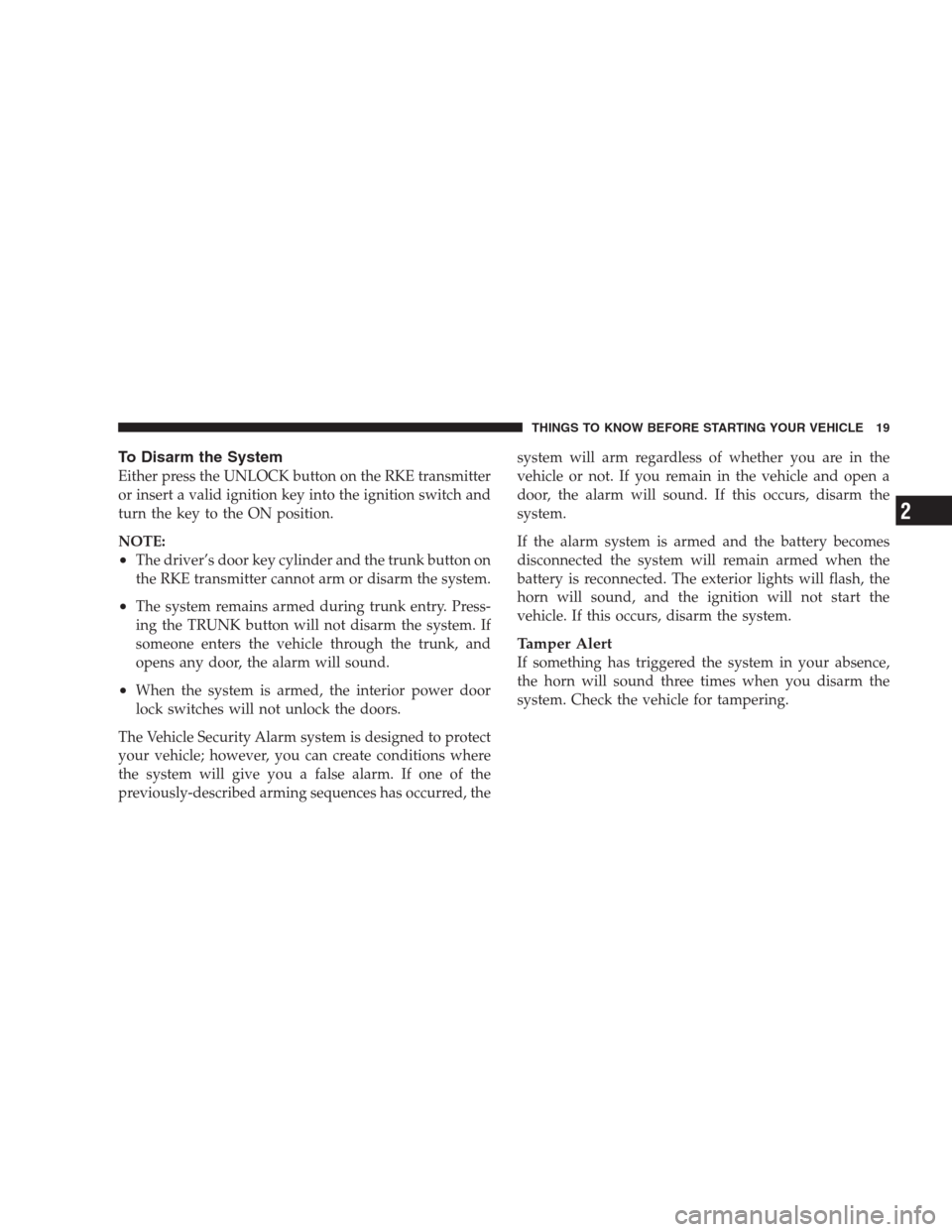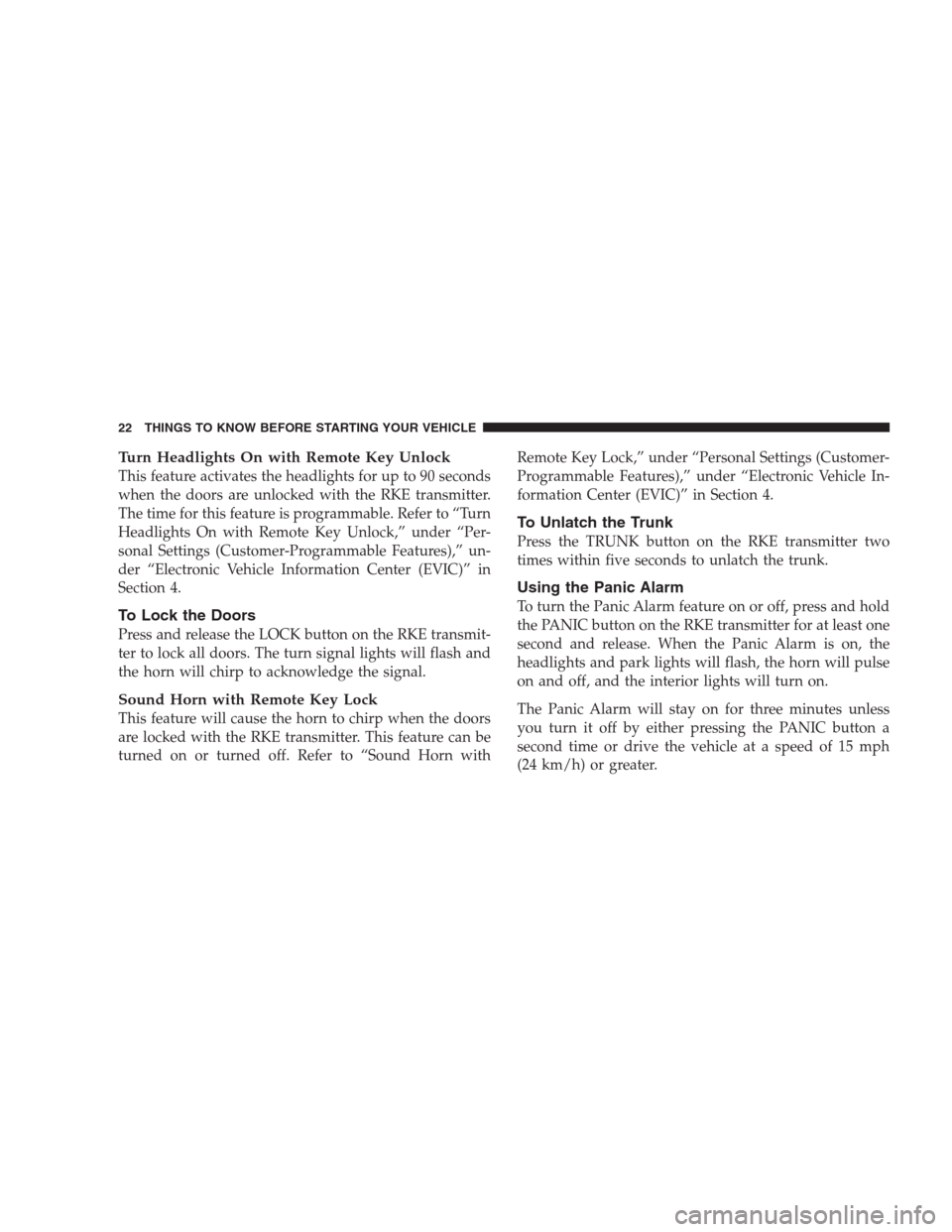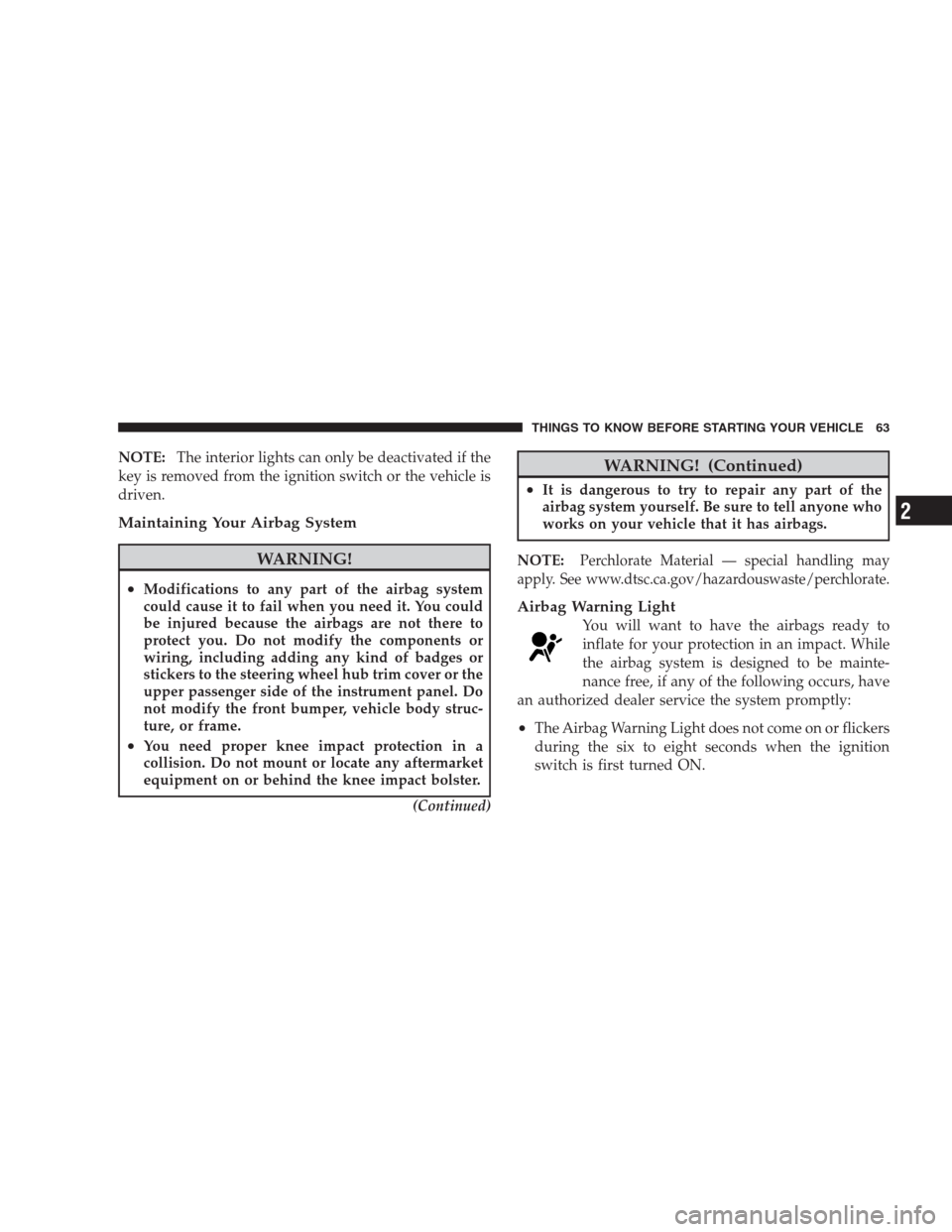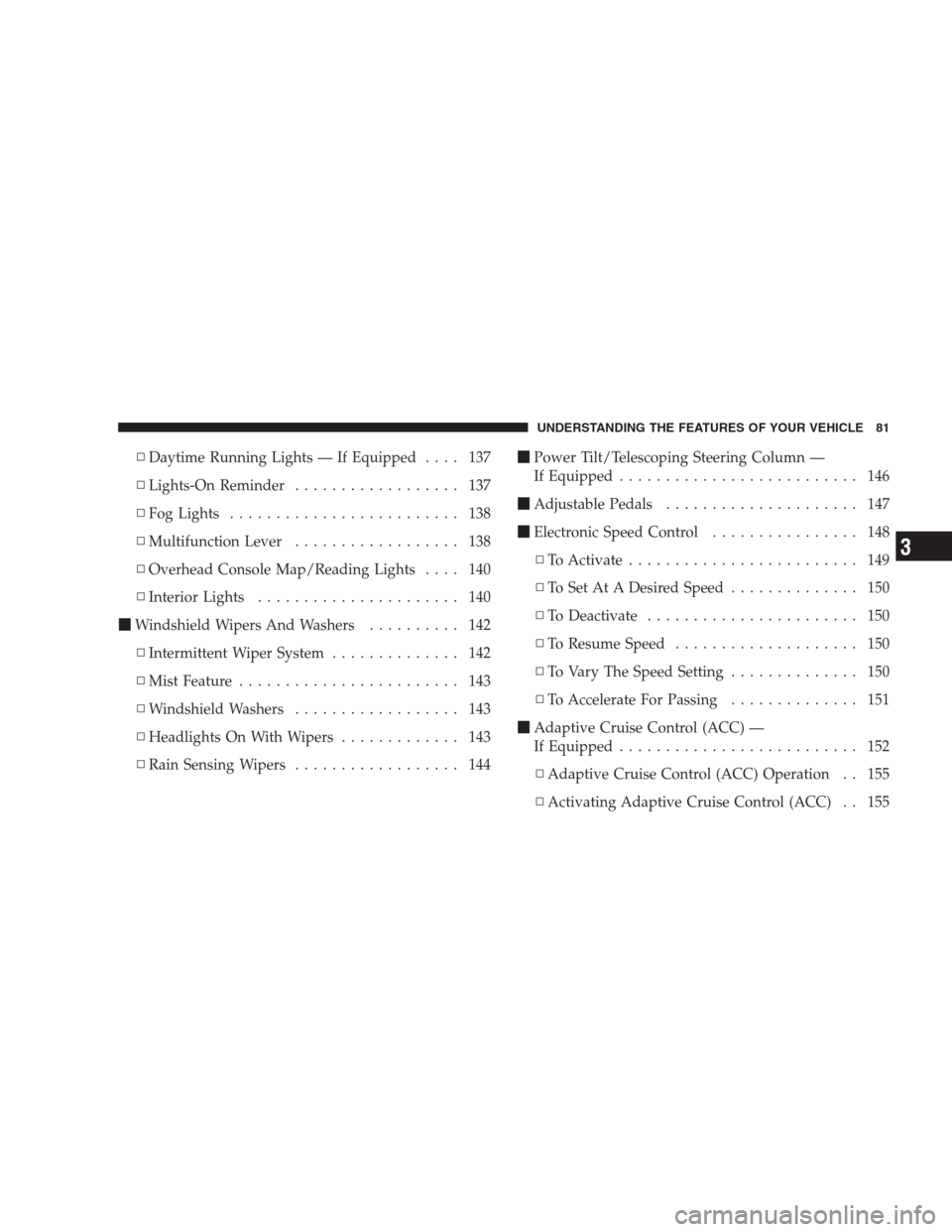Page 21 of 493

To Disarm the System
Either press the UNLOCK button on the RKE transmitter
or insert a valid ignition key into the ignition switch and
turn the key to the ON position.
NOTE:
•The driver’s door key cylinder and the trunk button on
the RKE transmitter cannot arm or disarm the system.
•The system remains armed during trunk entry. Press-
ing the TRUNK button will not disarm the system. If
someone enters the vehicle through the trunk, and
opens any door, the alarm will sound.
•When the system is armed, the interior power door
lock switches will not unlock the doors.
The Vehicle Security Alarm system is designed to protect
your vehicle; however, you can create conditions where
the system will give you a false alarm. If one of the
previously-described arming sequences has occurred, thesystem will arm regardless of whether you are in the
vehicle or not. If you remain in the vehicle and open a
door, the alarm will sound. If this occurs, disarm the
system.
If the alarm system is armed and the battery becomes
disconnected the system will remain armed when the
battery is reconnected. The exterior lights will flash, the
horn will sound, and the ignition will not start the
vehicle. If this occurs, disarm the system.
Tamper Alert
If something has triggered the system in your absence,
the horn will sound three times when you disarm the
system. Check the vehicle for tampering.
THINGS TO KNOW BEFORE STARTING YOUR VEHICLE 19
2
Page 24 of 493

Turn Headlights On with Remote Key Unlock
This feature activates the headlights for up to 90 seconds
when the doors are unlocked with the RKE transmitter.
The time for this feature is programmable. Refer to “Turn
Headlights On with Remote Key Unlock,” under “Per-
sonal Settings (Customer-Programmable Features),” un-
der “Electronic Vehicle Information Center (EVIC)” in
Section 4.
To Lock the Doors
Press and release the LOCK button on the RKE transmit-
ter to lock all doors. The turn signal lights will flash and
the horn will chirp to acknowledge the signal.
Sound Horn with Remote Key Lock
This feature will cause the horn to chirp when the doors
are locked with the RKE transmitter. This feature can be
turned on or turned off. Refer to “Sound Horn withRemote Key Lock,” under “Personal Settings (Customer-
Programmable Features),” under “Electronic Vehicle In-
formation Center (EVIC)” in Section 4.
To Unlatch the Trunk
Press the TRUNK button on the RKE transmitter two
times within five seconds to unlatch the trunk.
Using the Panic Alarm
To turn the Panic Alarm feature on or off, press and hold
the PANIC button on the RKE transmitter for at least one
second and release. When the Panic Alarm is on, the
headlights and park lights will flash, the horn will pulse
on and off, and the interior lights will turn on.
The Panic Alarm will stay on for three minutes unless
you turn it off by either pressing the PANIC button a
second time or drive the vehicle at a speed of 15 mph
(24 km/h) or greater.
22 THINGS TO KNOW BEFORE STARTING YOUR VEHICLE
Page 25 of 493
NOTE:
•The interior lights will turn off if you turn the ignition
switch to the ACC or ON position while the Panic
Alarm is activated. However, the exterior lights and
horn will remain on.
•You may need to be less than 35 ft (11 m) from the
vehicle when using the transmitter to turn off the
Panic Alarm due to the radio frequency noises emitted
by the system.
Programming Additional Transmitters
Refer to Sentry Key�, “Customer Key Programming.”
If you do not have a programmed RKE transmitter,
contact your authorized dealer for details.
RKE Transmitter Battery Service
The recommended replacement battery is one CR2032
battery.
NOTE:
•Perchlorate Material — special handling may apply.
See www.dtsc.ca.gov/hazardouswaste/perchlorate
•Do not touch the battery terminals that are on the back
housing or the printed circuit board.
THINGS TO KNOW BEFORE STARTING YOUR VEHICLE 23
2
Page 55 of 493
WARNING! (Continued)
•Do not mount any accessories to the knee bolster
such as alarm lights, stereos, citizens band radios
etc.
This vehicle may also be equipped with supplemental
side curtain airbags to protect the driver and passengers
sitting next to a window and/or supplemental front
seat-mounted side airbags.
If the vehicle is equipped with supplemental side curtain
airbags, they are located above the side windows. Their
covers are also labeled SRS AIRBAG.
NOTE:Airbag covers may not be obvious in the interior
trim, but they will open to allow airbag deployment.
Window Airbag
THINGS TO KNOW BEFORE STARTING YOUR VEHICLE 53
2
Page 64 of 493

However, if you haven’t healed significantly within a
few days or if you have any blistering, see your doctor
immediately.
•As the airbags deflate, you may see some smoke-like
particles. The particles are a normal by-product of the
process that generates the nontoxic gas used for airbag
inflation. These airborne particles may irritate the skin,
eyes, nose, or throat. If you have skin or eye irritation,
rinse the area with cool water. For nose or throat
irritation, move to fresh air. If the irritation continues,
see your doctor. If these particles settle on your
clothing, follow the garment manufacturer’s instruc-
tions for cleaning.
•It is not advisable to drive your vehicle after the
airbags have been deployed. If you are involved in
another collision, the airbags will not be in place to
protect you.
WARNING!
Deployed airbags can’t protect you in another colli-
sion. Have the airbags replaced by an authorized
dealer as soon as possible.
Enhanced Accident Response System
In the event of an impact that causes airbag deployment,
with the vehicle stopped, and the vehicle communication
network intact, and the power intact, the Enhanced
Accident Response System performs the following func-
tions:
•Cuts off fuel to the engine.
•Flashes hazard lights.
•Turns on the interior lights, which remain on as long as
the battery has power or until the ignition key is
removed.
•Unlocks the doors automatically.
62 THINGS TO KNOW BEFORE STARTING YOUR VEHICLE
Page 65 of 493

NOTE:The interior lights can only be deactivated if the
key is removed from the ignition switch or the vehicle is
driven.
Maintaining Your Airbag System
WARNING!
•Modifications to any part of the airbag system
could cause it to fail when you need it. You could
be injured because the airbags are not there to
protect you. Do not modify the components or
wiring, including adding any kind of badges or
stickers to the steering wheel hub trim cover or the
upper passenger side of the instrument panel. Do
not modify the front bumper, vehicle body struc-
ture, or frame.
•You need proper knee impact protection in a
collision. Do not mount or locate any aftermarket
equipment on or behind the knee impact bolster.
(Continued)
WARNING! (Continued)
•It is dangerous to try to repair any part of the
airbag system yourself. Be sure to tell anyone who
works on your vehicle that it has airbags.
NOTE:
Perchlorate Material — special handling may
apply. See www.dtsc.ca.gov/hazardouswaste/perchlorate.
Airbag Warning Light
You will want to have the airbags ready to
inflate for your protection in an impact. While
the airbag system is designed to be mainte-
nance free, if any of the following occurs, have
an authorized dealer service the system promptly:
•The Airbag Warning Light does not come on or flickers
during the six to eight seconds when the ignition
switch is first turned ON.
THINGS TO KNOW BEFORE STARTING YOUR VEHICLE 63
2
Page 83 of 493

▫Daytime Running Lights — If Equipped.... 137
▫Lights-On Reminder.................. 137
▫Fog Lights......................... 138
▫Multifunction Lever.................. 138
▫Overhead Console Map/Reading Lights.... 140
▫Interior Lights...................... 140
�Windshield Wipers And Washers.......... 142
▫Intermittent Wiper System.............. 142
▫Mist Feature........................ 143
▫Windshield Washers.................. 143
▫Headlights On With Wipers............. 143
▫Rain Sensing Wipers.................. 144�Power Tilt/Telescoping Steering Column —
If Equipped.......................... 146
�Adjustable Pedals..................... 147
�Electronic Speed Control................ 148
▫To Activate......................... 149
▫To Set At A Desired Speed.............. 150
▫To Deactivate....................... 150
▫To Resume Speed.................... 150
▫To Vary The Speed Setting.............. 150
▫To Accelerate For Passing.............. 151
�Adaptive Cruise Control (ACC) —
If Equipped.......................... 152
▫Adaptive Cruise Control (ACC) Operation . . 155
▫Activating Adaptive Cruise Control (ACC) . . 155
UNDERSTANDING THE FEATURES OF YOUR VEHICLE 81
3
Page 136 of 493
To prevent possible damage, do not slam the hood to
close it. Lower the hood, until it is open approximately
6 in (15 cm), and then drop it. This should secure both
latches. Never drive your vehicle unless the hood is fully
closed, with both latches engaged.
WARNING!
If the hood is not fully latched, it could fly up when
the vehicle is moving and block your forward vision.
You could have a collision. Be sure all hood latches
are fully latched before driving.
LIGHTS
Headlight Switch
The headlight switch is located on the left side of
the instrument panel. This switch controls theoperation of the headlights, parking lights, instrument
panel lights, instrument panel light dimming, interior
lights, and fog lights.Headlight Switch
134 UNDERSTANDING THE FEATURES OF YOUR VEHICLE